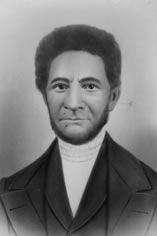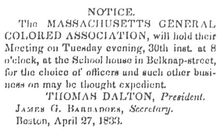John T. Hilton
John Telemachus Hilton (April 1801 – March 5, 1864) was an African-American abolitionist who established barber, furniture dealer and employment agency businesses.[1] He was a Prince Hall Mason and established the Prince Hall National Grand Lodge of North America and served as its first National Grand Master for ten years. He also was a founding member of the Massachusetts General Colored Association, and active member and author in the Anti-Slavery movement.

Both John T. Hilton and his wife, Lavinia (Ames) Hilton, were active in the Anti-Slavery and Temperance Societies.
Early life
John Telemachus Hilton was born in 1801 in Chester County, Pennsylvania.[1]
Hilton traveled to Boston at the age of 17 and married nineteen-year-old Lavinia M. Ames on April 1, 1825, in Boston;[2] they would have three sons and two daughters.[3]
By 1830, John T. Hilton had a storefront for a hairdressing shop; the store also included his employment agency, retail sales, furniture commission sales and local event ticket sales.[1][4]
Freemason
On June 24, 1847, John T. Hilton helped organized the National Grand Lodge of Prince Hall Freemasonry and served as the first National Grand Master. Hilton was Grand Master of the National Grand Lodge of North America for ten years. In his honor, the Lynn, Massachusetts lodge was named the John T. Hilton Lodge.[5]
He was the first of Boston's African-American men to have "a portrait commissioned by Prince Hall Masonic Lodge [1] ."
Antislavery and Community Activities
Hilton wrote An Address, Delivered Before the African Grand Lodge of Boston, No. 459, June 24, 1828, by John T. Hilton: On the Annual Festival, of St. John the Baptist (Boston, 1828)" and Thomas Dalton (abolitionist) and David Walker oversaw its publication.[6]
Massachusetts General Colored Association

Hilton and other Prince Hall Freemasons were founding members of the Massachusetts General Colored Association.[7] The organization was said to have had "among its leaders the most spirited and intelligent colored citizens of Boston."[8]
Anti-Slavery Society
In 1854, Hilton became vice-president of the Massachusetts Anti-Slavery Society.[4] He was also a member of the Boston Vigilance Committee.[9]
Hilton's wife Lavinia was described as one of the "young intellectuals and active abolitionists in the 1830s," along with Susan Paul. Lavinia Hilton and Susan Paul were members of the Boston Female Anti-Slavery Society.[10]
Temperance Society
By 1838, Hilton was the president of the New England Temperance Society of Colored Americans; His wife Lavina was the treasurer of the women's group.[11]
Publications
Author
- Address Delivered Before the African Grand Lodge, Boston, No. 459, June 24, 1828. David Hooton. 1828.
- Proceedings of the Presentation Meeting Held in Boston, Dec. 17, 1855. R.F. Wallcut. 1856.
Co-author
- John T. Hilton; William Cooper Nell; Charles Wesley Slack; Wendell Phillips; William Lloyd Garrison; Charles Lenox Remond (1856). Triumph of Equal School Rights in Boston: Proceedings of the Presentation Meeting Held in Boston, Dec. 17, 1855: Including Addresses by John T. Hilton, Wm. C. Nell, Charles W. Slack, Wendell Phillips, Wm. Lloyd Garrison, Charles Lennox Remond. R.F. Wallcut.
Marriage and family
Hilton and his wife, Lavinia,[5] were both members of the African Baptist Church. Mrs. Hilton was a member of the female Anti-Slavery Society.[4] At least for the period between 1848 and 1851, Hilton lived at 3 Second Street in the 5th Ward of Boston; He worked as a barber.[12]
Their eldest daughter, Lavinia L. Hilton, attended the Exclusive School in Beacon Hill and the Alumni Grammar School in Cambridge. Lavinia assisted her father in his Anti-Slavery efforts by handing out handbills for the Boston Vigilance Committee. She married John M. Lenox and lived in Waltham, Massachusetts: "She and her husband did much to dispel prejudice in that place, and to increase the antislavery sentiment there existing."[4]
An ancestor of Lavinia Ames Hilton was Prince Ames, a Revolutionary War soldier who served at Bunker Hill.[4]
Death
Hilton died on March 5, 1864, in Brighton, Massachusetts of chronic hepatitis. He was 62 years and 11 months of age, his profession was hairdresser.[1][13] His wife died on November 2, 1882, in Cambridge, Massachusetts.[4]
References
- "Black Entrepreneurs brochure" (PDF). Economic Adventure. Archived from the original (PDF) on September 13, 2012. Retrieved May 1, 2013.
- Massachusetts Marriages
- 1860 Federal Census for Sixth Ward of the City of Boston
- "Reminiscences, Nancy Prince, July 1894, by An Old Bostonian". Emory Women Writers Resource Project. Retrieved May 1, 2013.
- Cromwell (1994). The Other Brahmins: Boston's Black Upper Class, 1750-1950. University of Arkansas Press. p. 225. ISBN 978-1-61075-293-0. Retrieved May 2, 2013.
- Peter Hinks (1997). To Awaken My Afflicted Brethren: David Walker and the Problem of Antebellum Slave Resistance. Penn State Press. p. 116. ISBN 978-0-271-04274-9. Retrieved April 23, 2013.
- Nina Mjagkij (September 1, 2003). Organizing Black America: An Encyclopedia of African American Associations. Taylor & Francis. p. 282. ISBN 978-0-203-80119-2. Retrieved April 23, 2013.
- Cromwell (1994). The Other Brahmins: Boston's Black Upper Class, 1750-1950. University of Arkansas Press. pp. 39. ISBN 978-1-61075-293-0. Retrieved April 23, 2013.
- Bearse, Austin (1880). Reminiscences of Fugitive-Slave Law Days in Boston. Boston: Warren Richardson. p. 4.

- Occasional Paper. The Program. 1973. p. 81. Retrieved May 2, 2013.
- Jean Fagan Yellin; John C Van Horne (1994). "The" Abolitionist Sisterhood: Women's Political Culture in Antebellum America. Cornell University Press. p. 134. ISBN 978-0-8014-8011-9. Retrieved May 2, 2013.
- John Telemachus Hilton. African-Americans in Antebellum Boston database. Retrieved May 3, 2013.
- Brighton, Massachusetts: Births, Marriages and Deaths 1771-1873. Town and City Clerks of Massachusetts. Massachusetts Vital and Town Records. Provo, UT: Holbrook Research Institute (Jay and Delene Holbrook).
Further reading
- Franklin A. Dorman (June 1, 1998). Twenty families of color in Massachusetts: 1742-1998. New England Historic Genealogical Society. ISBN 978-0-88082-077-6.
- Report of the minority of the committee: upon the petitions of John T. Hilton and others, colored citizens of Boston, praying for the abolition of the Smith School, and that colored children may be permitted to attend the other schools of the city. Boston: Order of the School Committee. 1849.
